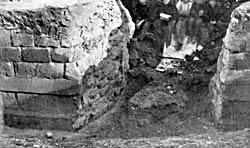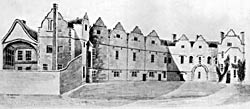
Overview: the 16th-17th centuries

Remains of the medieval town wall discovered at the top of Market Street in 1866.
Medieval
From the earliest maps of 1609 and 1610, we know that by the turn of the seventeenth century Nottingham still sat within its medieval boundaries. Empty plots depicted in the east and north-east areas of the town suggest there may even have been some contraction from its medieval peak. So much stone had been taken from the town wall that it had virtually disappeared. A new west-east route across the northern edge of the town had been created. This was used by heavy commercial traffic, particularly horses and carts, carrying coal from the pits at Wollaton to Trent Bridge. The stone for building Wollaton Hall, which was funded by coal sales, was probably among goods passing in the opposite direction. Houses intended for the poor had been built along the line of this route, and developments to the north of the town are shown on a birds-eye view of 1675.
From the 1580s population rose slowly, but the total was kept in check by food shortages and by depressingly regular outbreaks of plague. This stopped being a major killer by the 1660s and 1670s, but there was no respite since it was rapidly followed by the scourge of the eighteenth century, smallpox.
Malting and tanning were among the main occupational interests in the town. The malting trade was supported by the prosperous arable farming in the area, and many Nottingham people farmed either full or part time, reflecting the close contacts between town and countryside. Innkeepers brewed their own beer which they often stored in caves below their premises. The traveller Celia Fiennes, who visited Nottingham in the 1690s, commented that ‘Nottingham is famous for good ale so for Cellars they are all dug out of the rocks and so are very cool ... I drank good ale'.
Nottingham was a market town. A daily market was held at Weekday Cross, but the highlight of the week was the great Saturday Market in the market place. Visitors came to Goose Fair, first named as such in the contemporary record in 1542. They also attended Lenton Fair, which survived the dissolution of the monasteries and was an important regional and even national interchange for goods in the seventeenth century. Many of the goods bought and sold at the fairs reached Nottingham by packhorse, but there was also a flourishing trade along the River Trent: fish and timber were among the goods brought in, and coal was sold along the river and into Lincolnshire.

Watercolour painting of Thurland Hall (formerly Clare House) by A Parker (1831).
Most sixteenth-century houses in the town would have been timber frame structures, built on two or three storeys. The timber frames were infilled with a daub made of clay, and many were rendered on the outside with a lime plaster coating. Only higher status houses had tiles; the rest were thatched, creating fire hazards. A number of larger buildings of medieval origin survived in 1609-10, including Plumptre Hospital and Thurland Hall.
Nottingham, because of its strategic position between London and northern